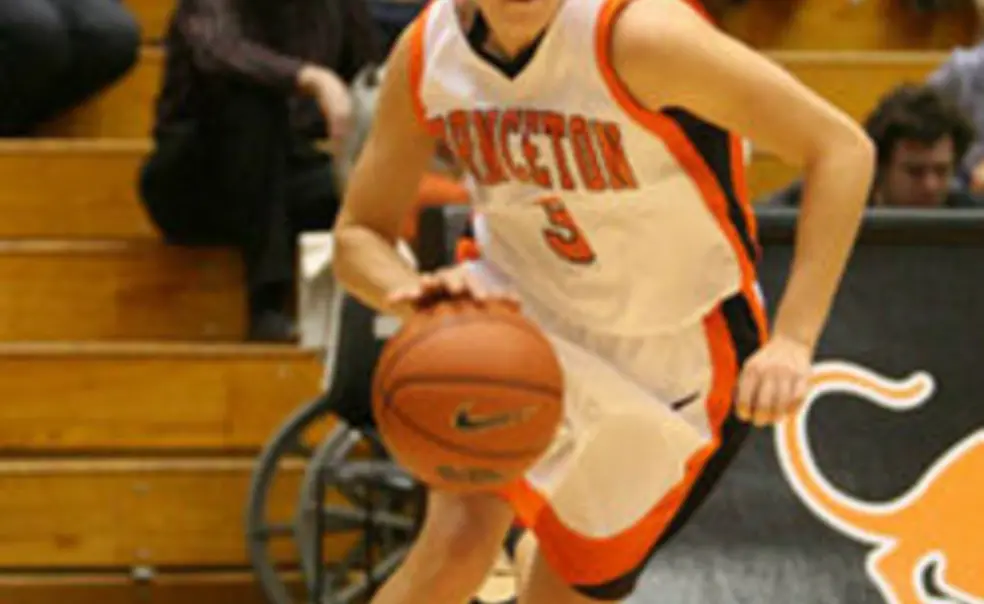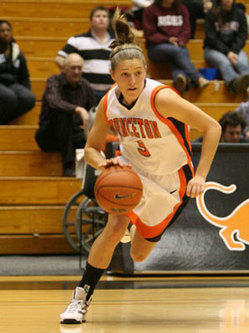Princeton tops women's hoops forecast, Harvard leads challengers
Lauren Polansky '13 and the Tigers opened their Ivy title defense with a Jan. 8 win over Penn. (© Beverly Schaefer)
Rasheed, who suffered a season-ending knee injury in Princeton’s Dec. 29 win at Davidson, led Princeton in scoring during its perfect 14-0 Ivy season last year and upped her average by a point this year, to 16.4 points per game. Head coach Courtney Banghart said the Tigers will need to take on added responsibility.
“She takes 14.6 shots a game, so we need those shots to come from other people,” Banghart said. “Offensively, we have to find a rhythm for 40 minutes without a kid who makes plays like she does.”
Princeton has plenty of scorers – Addie Micir ’11, Devona Allgood ’12, and Lauren Edwards ’12 each average 11 or more points per game – and playmaking point guard Lauren Polansky ’13 is in the middle of another solid year, with a 1.67 assist-turnover ratio (second-best in the league).
Below, a team-by-team look at the league. (Teams are listed in order of the preseason media poll.)
Princeton (12-3 overall, 1-0 Ivy) The January exam break may have been a blessing for this year’s Tigers, who played a difficult pair of road games in late December and then got confirmation that they would be without Rasheed for the rest of the season.
“It’s good for our kids to have a mental and physical chance to regroup,” Banghart said. The break also has been good for the coaches, she added, because it gives them a chance to think about any changes that might need to be made to help the Tigers succeed without Rasheed.
In nonconference play, Princeton had one of the most impressive starts in recent Ivy history, beating Southern California and Wake Forest and dropping close games to Rutgers, Vanderbilt, and St. Joseph’s.
Harvard (8-6, 1-0) The score of Harvard’s Ivy opener – an 82-49 win over Dartmouth – would turn heads in most years. Dartmouth and Harvard, after all, have been to the women’s side of the Ivies what Penn and Princeton once were on the men’s side. But as good as the Crimson may be, the score likely was shaped as much by Dartmouth’s inexperience as it was by Harvard’s dominance.
Harvard has experience and talent, with five starters back from a team that went 11-3 in Ivy games last season and earned an invitation to the Women’s NIT. Senior forward Emma Markley, an All-Ivy pick last year, has been productive as a scorer, rebounder, and defender (her 27 blocks rank second in the league). Junior guard Brogan Berry leads the team with 14.4 points per game. Harvard is particularly dangerous on the perimeter: Berry, Victoria Lippert, and Christine Clark each shoot better than 44 percent on three-pointers.
Head coach Kathy Delaney-Smith said that her team has more depth this season, thanks in part to Clark, a freshman whom Delaney-Smith predicts will become “one of the most exciting players in the league.” Jasmine Evans, a sophomore guard who missed last year with an injury, has emerged as an important reserve and a defensive stalwart.
Dartmouth (4-11, 0-1) Like Princeton, Dartmouth is learning to play without one of its top players. Senior Brittney Smith, a 1,000-point scorer and Ivy Player of the Year in 2008-09, was lost to injury just seven games into the season. She’d averaged 13.1 points and 9.7 rebounds up to that point.
“We had to reinvent ourselves,” veteran head coach Chris Wielgus said. “As of December, Brittany was playing her best basketball. … We feel awful for her, but you can’t have any personal pity party or team pity party. We had to pick ourselves up, and we’re relying very heavily on a young group.”
The starting lineup features two seniors, two freshmen, and a sophomore. Cassie Cooper, a senior who missed most of last season due to injury, has emerged as a solid player in the post, and sophomore Faziah Steen has been the Big Green’s top three-point shooter. Dartmouth struggled offensively in its Ivy opener, shooting 31.3 percent from the field in the lopsided loss at Harvard.
Yale (5-10, 1-0) Bulldogs head coach Chris Gobrecht admits that her team has been inconsistent. “If you look at Yale, and you look our preseason performance, you’re definitely scratching your head,” she said. “I know I’m scratching mine.”
After opening 1-7, the Bulldogs scored a shocking 91-85 upset win over No. 14 Florida State Dec. 18 – probably the most impressive win from any Ivy team this year. Two games later, they dropped a 62-44 game at Fordham, allowing the Rams to go on an 18-0 second-half run. With the exception of the Florida State game, Yale has not beaten a team that currently has a winning record.
Injuries are partly to blame. Starters Yoyo Greenfield, Megan Vasquez, Janna Graf, and Michelle Cashen each have missed games, but Gobrecht is hopeful that all four will be healthy when the league’s two-game weekends begin.
Columbia (2-13, 1-0) With the graduation of Ivy Player of the Year Judie Lomax and a string of difficult nonconference opponents, the young Lions struggled in the first half of the season before picking up their first win last week against Cornell. Head coach Paul Nixon said that his team was competitive in many of its early losses and has seen growth from new contributors, particularly on the offensive end.
Senior guard Kathleen Barry, an All-Ivy honorable mention last year, leads the team in both scoring (10.5 points per game) and rebounding (6.4 rebounds per game). Three freshmen – Brianna Orlich, Taylor Ward, and Courtney Bradford – have started at least half of the Lions’ games and could become the core of Columbia’s rebuilding effort.
Brown (4-11, 0-1) Brown beat Florida, a solid nonconference opponent, in early December, but the Bears have struggled since then, dropping five of their last six games, including their Ivy opener against Yale.
Brown has a pair of impressive youngsters in sophomore Sheila Dixon (11.3 points per game) and freshman guard Lauren Clarke (10.5 points per game), and so far, the team has maintained continuity with the same starting five in each of its 15 games. In most instances, the Bears have stayed within 10 points of their opponents, but poor shooting (34.6 percent from the field) has limited their opportunities to finish on top.
Cornell (1-12, 0-1) Like Columbia, the Big Red is a young squad that struggled in its nonconference games. After rotating a series of players through the starting lineup, head coach Dayna Smith has settled on a starting five that features two sophomores and three freshmen.
Clare Fitzpatrick, an Ivy All-Rookie selection last year, is Cornell’s top scorer (10.7 points per game) and the only player to start every game this season. Sophomore forward Kristina Danielak (56.8 field-goal percentage) and freshman guard Allyson DiMagno (7.9 points per game) have emerged as key contributors in recent weeks.
Penn (6-8, 0-1) The Quakers may be the league’s most improved team. Picked by the media to finish last, they posted five wins in their first 10 games before beginning a difficult stretch in early January. Freshman guard Alyssa Baron, the league’s top active scorer (15.5 points per game) could contend for Ivy Rookie of the Year honors.
The Quakers lack consistency on offense, but they have been able to stay close in several games because of their defense, an area of emphasis for second-year head coach Mike McLaughlin. Penn allows just 54.6 points per game, best in the Ivies, and is one of three league teams with a positive rebounding margin. (Princeton and Harvard are the other two.)













No responses yet